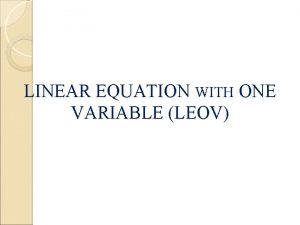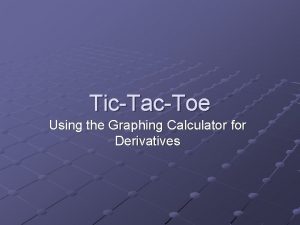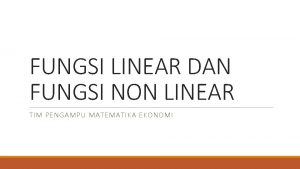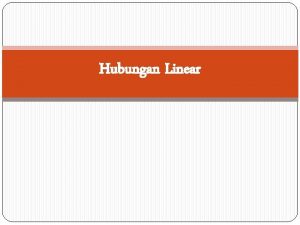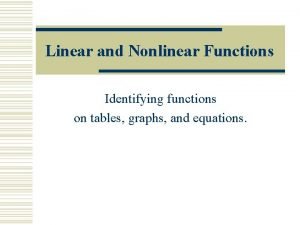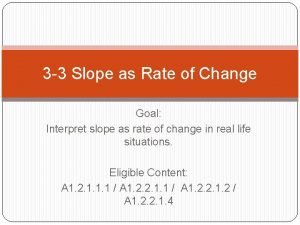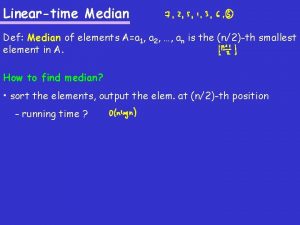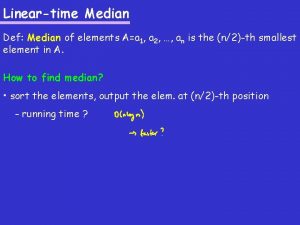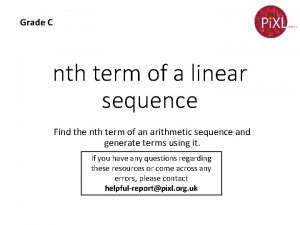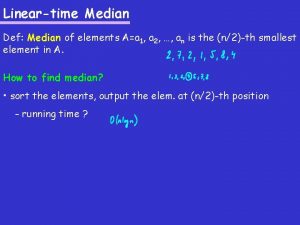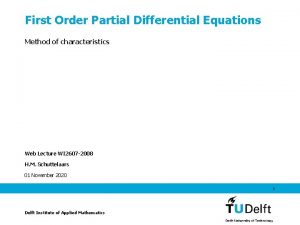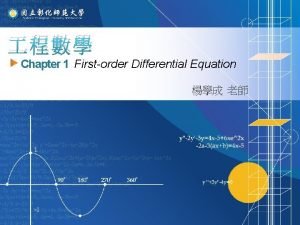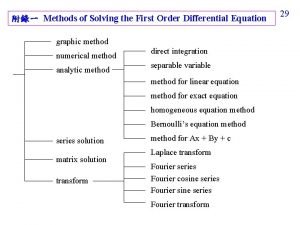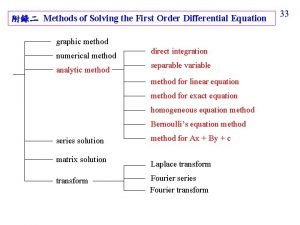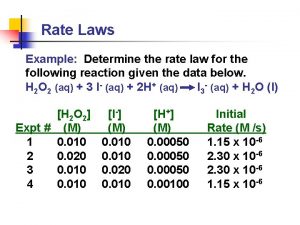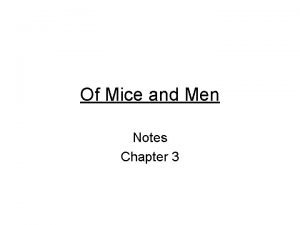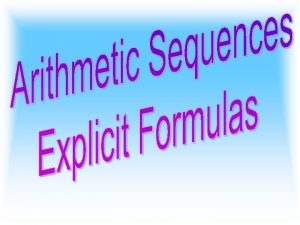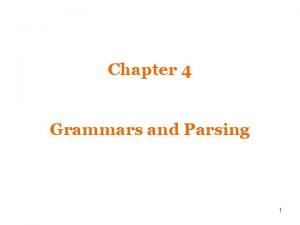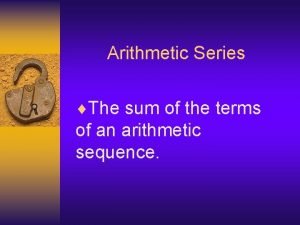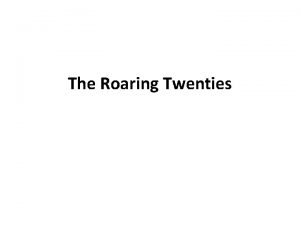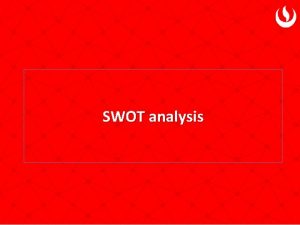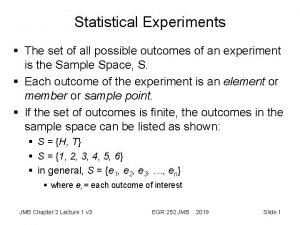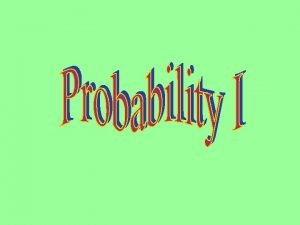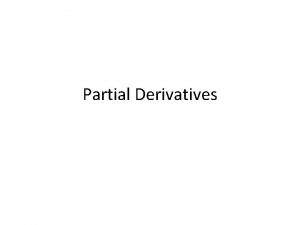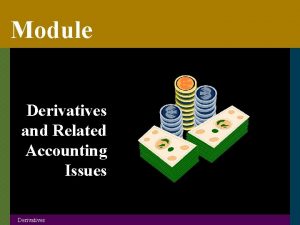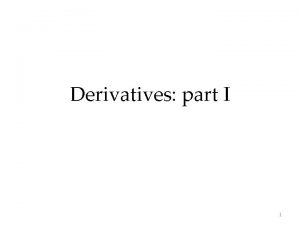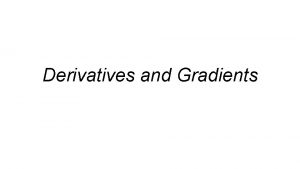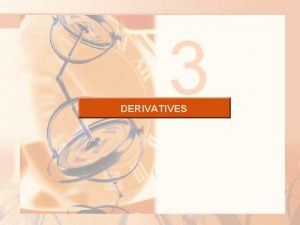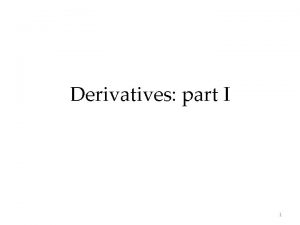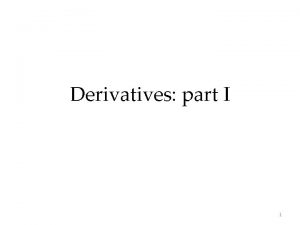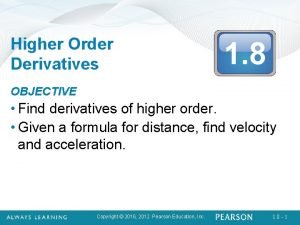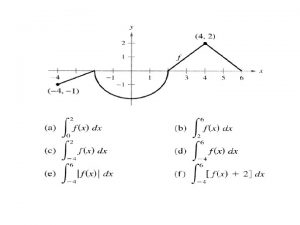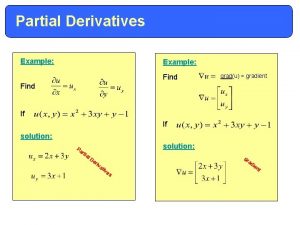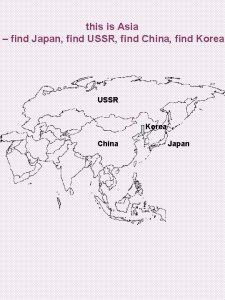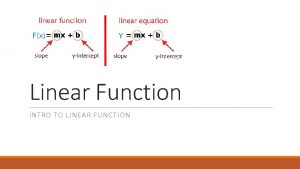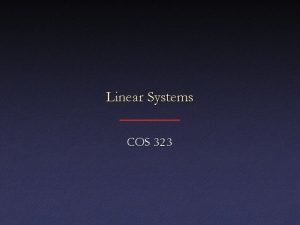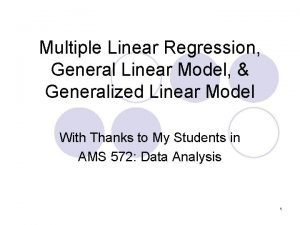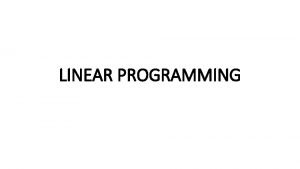1 Derivatives Outcomes Find first derivatives of linear































![32 Solve Context Problems 2012 OL P 1 Q 9 [continued] 32 Solve Context Problems 2012 OL P 1 Q 9 [continued]](https://slidetodoc.com/presentation_image_h2/353c3342874160a4a7ce418fe9e7b871/image-32.jpg)

![34 2012 (S) OL P 1 Q 9 [continued] Solve Context Problems ii. Find 34 2012 (S) OL P 1 Q 9 [continued] Solve Context Problems ii. Find](https://slidetodoc.com/presentation_image_h2/353c3342874160a4a7ce418fe9e7b871/image-34.jpg)















- Slides: 49

1 Derivatives – Outcomes Find first derivatives of linear, quadratic, and cubic functions. Find second derivatives of linear, quadratic, and cubic functions. Solve problems about slopes and tangent lines. Solve problems about maxima and minima. Solve problems about rates of change. Solve context problems. Sketch curves using derivatives.

2 Find First Derivatives

3 In words, “multiply by the current power, then reduce the power by 1” Find First Derivatives

4 Find First Derivatives

5 Find First Derivatives

6 Find First Derivatives e. g. Find the first derivative of each of the following:

7 Find First Derivatives 2011(S) OL P 1 Q 8 2006 OL P 1 Q 7 2007 OL P 1 Q 6

8 Find Second Derivatives You always have to find the first derivative before finding the second derivative.

9 Find Second Derivatives e. g. Find the second derivative of each of the following:

10 Solve Problems about Slopes and Tangents

11 Solve Problems about Slopes and Tangents

12 Solve Problems about Slopes and Tangents

13 Solve Problems about Slopes and Tangents

14 Solve Problems about Slopes and Tangents

15 Solve Problems about Slopes and Tangents 2003 OL P 1 Q 8

16 2012 (O)OL P 1 Q 8 Solve Problems about Slopes and Tangents

17 We often refer to “local” maximum and minimum to distinguish when there are more than one of either Solve Problems about Maxima and Minima Important points for curves are turning points / stationary points. They come in two types: maximum and minimum.

18 Solve Problems about Maxima and Minima If the derivative of a function represents the slope of the tangent, what value does the derivative take at turning points?

19 Solve Problems about Maxima and Minima How do you know which is maximum and minimum?

20 Solve Problems about Maxima and Minima

21 Solve Problems about Maxima and Minima

22 Solve Problems about Maxima and Minima Know your curve:

23 Solve Problems about Maxima and Minima

24 Solve Problems about Maxima and Minima

25 Solve Problems about Maxima and Minima 2006 OL P 1 Q 6

26 Solve Problems about Maxima and Minima 2005 OL P 1 Q 6

27 Solve Problems about Rates of Change

28 Solve Problems about Rates of Change ANY number less than 4 is fine: 0 is easy!

29 Solve Problems about Rates of Change

30 Solve Context Problems For many word problems, real-world terms are used in place of mathematical ones. e. g. instead of maximum, you may be asked about the largest, biggest, longest, tallest, most, heaviest, quickest, strongest, etc. e. g. instead of minimum, you may be asked about the smallest, shortest, least, lightest, slowest, weakest, etc. Likewise, instead of increasing/decreasing, you will see bigger/smaller, taller/shorter, heavier/lighter etc.

31 Solve Context Problems 2012 OL P 1 Q 9
![32 Solve Context Problems 2012 OL P 1 Q 9 continued 32 Solve Context Problems 2012 OL P 1 Q 9 [continued]](https://slidetodoc.com/presentation_image_h2/353c3342874160a4a7ce418fe9e7b871/image-32.jpg)
32 Solve Context Problems 2012 OL P 1 Q 9 [continued]

33 2012 (S) OL P 1 Q 9 Solve Context Problems
![34 2012 S OL P 1 Q 9 continued Solve Context Problems ii Find 34 2012 (S) OL P 1 Q 9 [continued] Solve Context Problems ii. Find](https://slidetodoc.com/presentation_image_h2/353c3342874160a4a7ce418fe9e7b871/image-34.jpg)
34 2012 (S) OL P 1 Q 9 [continued] Solve Context Problems ii. Find the amount of nitrogen that he must use in order to maximise the amount of wheat produced. iii. What is the maximum possible amount of wheat produced per hectare? iv. The farmer’s total costs for producing the wheat are € 1300 per hectare. He can sell the wheat for € 160 per tonne. He can also get € 75 per hectare for the leftover straw. If he achieves the maximum amount of wheat, what is his profit per hectare?

35 Solve Context Problems “at rest” means velocity is zero

36 Solve Context Problems 2003 OL P 1 Q 7

37 Solve Context Problems 2004 OL P 1 Q 7

38 Solve Context Problems 2006 OL P 1 Q 7

39 Solve Context Problems Area and volume problems are also very common. You often have to create a formula for area or volume from given measurements. e. g. A new rectangular garden is being built onto the side of a building. 600 m of fencing is to be used to close off the other three sides. Find its maximum area.

40 Solve Context Problems Draw diagram.

41 Solve Context Problems Form equation.

42 Solve Context Problems Set derivative to 0 and solve.

43 Solve Context Problems 2012 OL P 1 Q 9 iii. Find the value of x for which the paved area is as large as possible. iv. Find the number of slabs needed to pave this maximum area.

44 Sketch Curves using Derivatives Here is a graph of a cubic and its derivatives: What is happening to the order of the polynomial as we differentiate? Note how the turning points of one graph corresponds to a root of its derivative

45 Sketch Curves using Derivatives

46 Sketch Curves using Derivatives Turning points on one curve are roots on their derivatives:

47 Sketch Curves using Derivatives

48 Sketch Curves using Derivatives 2003 OL P 1 Q 6

49 Sketch Curves using Derivatives 2008 OL P 1 Q 8
 Leov math
Leov math Tic tac toe calculator
Tic tac toe calculator Tubotympanic recess
Tubotympanic recess Linear regression vs multiple regression
Linear regression vs multiple regression Contoh soal biseksi dan penyelesaiannya
Contoh soal biseksi dan penyelesaiannya Types of non linear text
Types of non linear text What is nonlinear plot
What is nonlinear plot Contoh soal metode tabel
Contoh soal metode tabel Non linear pipeline processor
Non linear pipeline processor What is nonlinear multimedia
What is nonlinear multimedia Left-linear grammar
Left-linear grammar Perbedaan fungsi linier dan non linier
Perbedaan fungsi linier dan non linier Contoh fungsi non linier
Contoh fungsi non linier Linear dependency
Linear dependency Linear algebra linear transformation
Linear algebra linear transformation Pembentukan persamaan linear
Pembentukan persamaan linear How to find maximum compression of a spring formula
How to find maximum compression of a spring formula Graphical method simultaneous equations
Graphical method simultaneous equations Linear or nonlinear tables
Linear or nonlinear tables Table is linear or nonlinear
Table is linear or nonlinear Difference between linear and nonlinear
Difference between linear and nonlinear Nonlinear video editing
Nonlinear video editing Simultaneous nonlinear equations
Simultaneous nonlinear equations Right linear grammar
Right linear grammar Texto com narrador personagem
Texto com narrador personagem Rate of change of a function
Rate of change of a function Median def
Median def Median linear time
Median linear time How to find the nth term linear sequence
How to find the nth term linear sequence Median def
Median def Characteristics method partial differential equations
Characteristics method partial differential equations Pde
Pde Orthogonal trajectories
Orthogonal trajectories Separable partial differential equations
Separable partial differential equations First-order differential equations
First-order differential equations How to find the rate constant of a first order reaction
How to find the rate constant of a first order reaction Find three similes in this first chapter
Find three similes in this first chapter How to find the common difference of an arithmetic sequence
How to find the common difference of an arithmetic sequence Find first and follow of grammar
Find first and follow of grammar Average of first 80 natural numbers
Average of first 80 natural numbers Expected outcome example
Expected outcome example Water cycle learning outcomes
Water cycle learning outcomes Notice writing learning objectives
Notice writing learning objectives Third step in planning
Third step in planning What were the economic outcomes of demobilization
What were the economic outcomes of demobilization Swot analysys
Swot analysys This is the set of all possible outcomes in an experiment
This is the set of all possible outcomes in an experiment Learning outcomes of rhymes
Learning outcomes of rhymes A collection of all possible outcomes.
A collection of all possible outcomes. Outcomes based accountability
Outcomes based accountability
